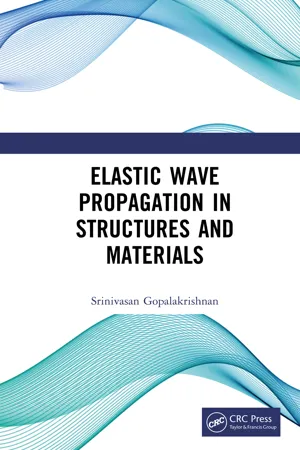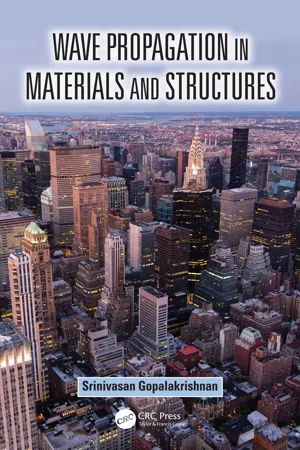Physics
Wave Speed
Wave speed refers to the rate at which a wave travels through a medium. It is determined by the frequency and wavelength of the wave, and is typically measured in meters per second. The formula for calculating wave speed is given by the product of the wavelength and frequency of the wave.
Written by Perlego with AI-assistance
Related key terms
Related key terms
1 of 4
Related key terms
1 of 3
3 Key excerpts on "Wave Speed"
- eBook - ePub
Photonics
Principles and Practices
- Abdul Al-Azzawi, Brian J. Thompson(Authors)
- 2017(Publication Date)
- CRC Press(Publisher)
8 m/s.The speed of a wave depends primarily on the nature of the wave disturbance and on the medium through which it passes. Under very close examination, the speed of wave propagation in certain media, called dispersive media, is also found to depend slightly on wave frequency. As a wave travels through a medium, the particles of the medium vibrate about their equilibrium positions in an identical fashion. However, the particles are in corresponding positions of their vibratory motion at different times. The position and motion of a particle indicate the phase of the wave. Particles that have the same displacement and are moving in the same direction are said to be in phase.17.5 TRIGONOMETRIC NOTATION OF WAVES
An angle θ is generated by rotating a line about its fixed endpoint from an initial position to a terminal position. If the rotation of the line from the initial side is counterclockwise, the angle is defined as positive. The angles are measured in degrees (°)and radians (rad). The measurement unit of an angle can be changed from one measure to the other, by using the definition of π rad = 180°.Figure 17.9 shows a particle P moving at constant speed in a circle of radius R having a projection, or shadow, that undergoes simple harmonic motion. The position of P is calculated by the velocity and acceleration as functions of time. The shadow of P on the x-axis oscillates back and forth between distances at +x and −x . Because cos θ is always between + 1 and − 1, the maximum displacement of the projection is equal to R . The position of the particle P at a specific time along the x-axis is given by:x = R cos θ00000000000000 (17.6)For uniform circular motion, the angle θ increases steadily with time t . Therefore, θ is proportional to t . The angular displacement of the particle at any time t is θ = ωt , and ω is the angular frequency. The particle linear speed in the circle is ωR , and centripetal acceleration is ω2 R . The time required to make one complete revolution (θ = 2π) is the period T . Thus, the relationship between the angle in radians and the time t - Srinivasan Gopalakrishnan(Author)
- 2022(Publication Date)
- CRC Press(Publisher)
Dispersion Relations, which is a plot of wave velocity with the frequency. These relations reveal the characteristics of different waves that are generated in a given material system.3.1CONCEPT OF WAVENUMBER, GROUP SPEEDS AND PHASE SPEEDS
A wave propagating in a medium can be represented asu ( x , t ) =(3.1)ei ( k x − ω t )Eqn. (3.1) is an alternate way of representing wave, which is given in Chapter 1 (Eqn. (1.1)). In the above equation k is the wavenumber, which specifies the behavior of the wave. The exponent in Eqn. (3.1)i ( k x − ω t )is called the phase of the wave. If the wave moves with constant phase, then we have(3.2)= 0 , ord ( i ( k x − ω t )d t=d xd tC p=ω kIn the above equation, Cprepresents the speed of the wave that moves with constant phase and hence it is called Phase speed. From the point of view of sending information, these waves are not useful. They are the same throughout the time and the space. Some quantities must therefore be modulated, such as frequency or amplitude, in order to convey information. The resulting wave may be a perturbation that acts over a short distance, which is called a wave packet- eBook - ePub
- Srinivasan Gopalakrishnan(Author)
- 2016(Publication Date)
- CRC Press(Publisher)
Chapter 4 . The most common integral transform used for transformation of variables to the frequency domain is the FFT, although more recently the wavelet transform and Laplace transform are also becoming popular. All of these transforms have a discrete representation and hence these are amenable to numerical implementation, which makes their use very attractive for wave propagation analysis. By transforming the problem into the frequency domain, the complexity of the governing partial differential equation is reduced by removing the time variable from the formulation, thus making the solution of the resulting ODE (in the 1D case) much simpler than the original PDE. In wave propagation problems, two parameters are very important, namely, the wavenumber and the speeds of the propagation. This chapter provides a general methodology to compute these quantities for a material system. There are many types of waves that can be generated in structure. Wavenumber expression reveals the type of waves that are generated. Hence, in wave propagation problems, two relations are very important, namely, spectrum relations, which is a plot of the wavenumber with the frequency, and dispersion relations, which is a plot of wave velocity with the frequency. These relations reveal the characteristics of different waves that are generated in a given material system.This chapter is organized as follows. First, the concept of phase and group speeds and their behavior in different mediums are explained. The expressions for evaluating them are derived. Next, some of the commonly used wave propagation terminologies are explained. This is followed by a subsection, wherein the spectral analysis of motion is explained for a general one-dimensional second-order material system. If the governing equation of the material system is derived using higher-order theories, computation of wavenumbers becomes extremely difficult. In such situations, we need to obtain them numerically. In the last part of this chapter, this issue is addressed, wherein general methods of numerically computing wavenumbers and their corresponding wave amplitudes is given.
A wave propagating in a medium can be represented as5.1 CONCEPT OF WAVENUMBER, GROUP SPEEDS, AND PHASE SPEEDSu ( x , t ) =e.i ( k x − ω t )( 5.1 )Eqn. (5.1) is an alternate way of representing a wave, which is given in Chapter 1 (Eqn. (1.1) . In the above equation, k is the wavenumber, which specifies the behavior of the wave. The exponent in Eqn. (5.1) i(kx – ωt
Index pages curate the most relevant extracts from our library of academic textbooks. They’ve been created using an in-house natural language model (NLM), each adding context and meaning to key research topics.
Explore more topic indexes
Explore more topic indexes
1 of 6
Explore more topic indexes
1 of 4


